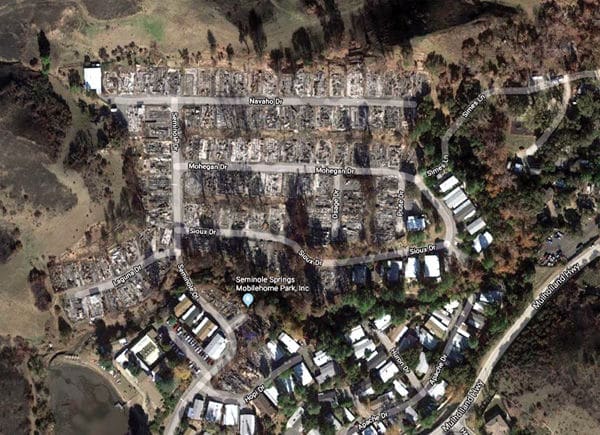
Nearly 15 months ago in the Woolsey Fire, more than half of the homes in the Seminole Springs Mobile Home Park (110 out of 215) were incinerated. The lakeside resident-owned co-op in the Santa Monica Mountains has a number of residents that either once lived in Malibu or currently work in Malibu. Fire victims there were assisted by agencies and nonprofits just after the fire, but now that their return to the park has been delayed for many months, they’re really feeling the financial strain.
Now, former residents are banding together.
“I’d like to put Seminole Springs Mobile Home Park back on the radar,” Jacqueline Peterson, a resident who recently formed the nonprofit SOAR Foundation—Seminole Opportunities Assisting Recovery—wrote in a recent message introducing the nonprofit. “To make folks aware of how dire their situation is and how many victims are in need of financial assistance. I want to help to raise funds for struggling families until they can be re-homed. Our story and the lengthy delay due to costing factors should be told.”
KTLA5 reported last November that repairs to gas and power lines, sewer system and storm drains in the mobile home park could cost as much as $10 million. In an LA Times article that same week, park board members said the infrastructure must be replaced before California Department of Housing & Community Development will allow new homes to be brought in.
As a result of heavy rains that occurred in the months after the fire, the reservoir next to Seminole Springs flooded and, “In order to save the lower portion of the mobile home park, which had not burned, a gouge was cut in the reservoir to release the water, leaving a now muddy bog,” Peterson wrote.
Because of that, it will take many additional months for displaced residents to be allowed to return to their homes. A significant amount of infrastructure around the reservoir, including retaining walls, will have to be built.
In the meantime, “Many residents are struggling to make payments on homes that were burnt in the Woolsey Fire, pay homeowners’ dues and high local rent prices,” Peterson wrote. “For many, the temporary living expense money from insurance has already run out as well as FEMA assistance, and they’re in desperate need of financial help.”
Courtney Tarbox, co-founder of the nonprofit Rebuilding Seminole Foundation, agreed that many residents are in trouble. She explained that just after the Woolsey Fire, their organization handed out emergency funds for interim housing, assisted living and other immediate needs. After being on hiatus, they now see a “new wave of need” as temporary living expenses begin running out and “the timeline for return just keeps getting extended.” Many also have a problem with homeowners’ insurance not covering the full cost of replacement, and older people unable to qualify for loans because of fixed incomes.
“One of the difficult parts right now is conducting a current needs assessment,” Tarbox said. “People have scattered and there’s fatigue on filling out paperwork, which is constant … Some people have started putting their lots up for sale, but they aren’t selling.”
Peterson worried about the fact that, “A majority of residents are over 70 years old and never dreamed they’d have to try and qualify for another loan or start all over again … Some have been forced to find other accommodation after living in Seminole for decades.”
Since the Woolsey Fire, she reported that “10 neighbors who were thriving pre-fire have now passed away. I firmly believe stress is the key factor. I see pain and heartache at every turn here. In addition, we also have many young families who lost everything and are struggling to make ends meet … People whose homes survived and are still living in the Park face the ghostlike experience of a community that now looks like a war zone.”
Over the past year, the park has received assistance from benefactors including Conejo Cares, Habitat for Humanity, The Malibu Foundation, LA Region Long Term Recovery Group, Cavalry Church, United Way, Church World Service and many others.
The LA Rams and Conejo Cares helped the park build a new playground. Homes damaged by smoke were repaired through a Habitat for Humanity program.
Peterson is planning three major fundraising events, and asks for volunteers and donated items and services. There will be a large concert event at Calamigos Ranch in mid-June, with the venue already donated by Glen Gerson. The second event would be a gala night, and the third would be a “giant BBQ.” She’s hoping to have everything donated for these events—venues, music, security, food, ticket sales, silent auction items, catering, flowers, valet, bars, permits and parking, among others. If you can help, please contact Jacqueline Peterson at seminoleassistrecovery@gmail.com or 818.851.2904.